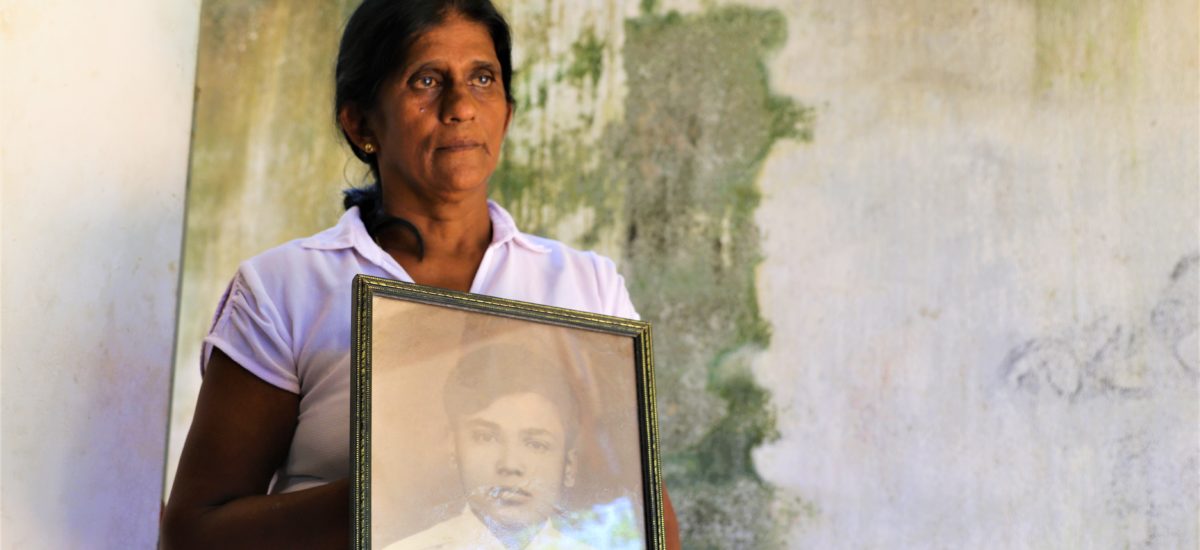Today is International Day of the Victims of Enforced Disappearances
“I am the luckiest mother in Sri Lanka. I got my son’s body back. There are thousands of mothers who never get their children’s bodies back.” Dr. Manorani Saravanamuttu was speaking after the inquest of her son, journalist and writer Richard de Zoysa, whose tortured body had washed up on a beach in Moratuwa in February 1990. Richard was dragged from home by armed men in the middle of the night.
He was one of the many thousands of young men and women who were exterminated by extra judicial means during the United National Party government’s crackdown on Marxist rebels from 1988 to 1990. Figures range from between 30,000 and 60,000. Several thousands more disappeared and still have not been found. Mass graves are unearthed from time to time but these investigations have led nowhere, just like the many commissions of inquiry held into disappearances reaching as far back as 1971, the time of the first insurrection. Some of the reports are yet to be made public.
No one has been brought to justice for Richard’s murder with Ranil Wickremesinghe, then a Minister in the government of President Ranasinghe Premadasa, dismissing the killing as “suicide or something else.”
Dr Saravanamuttu went on to form the Mother’ Front and became a voice for the poorer, marginalised women and men who continued to search desperately for their missing children, shunted from pillar to post, only to meet with hostility and rejection.
One of the early supporters of the families of the disappeared was opposition Sri Lanka Freedom Party politician Mahinda Rajapaksa, then a champion of human rights who even went to the UN Human Rights Council in Geneva to plead their cause.
In a twist of irony, 20 years later in January 2010, under the watch of President Mahinda Rajapaksa, journalist Prageeth Eknaligoda disappeared on his way home. His wife Sandhya continues to demand answers as to his whereabouts. The government has sought to dismiss his disappearance by dispensing stories about his alleged sightings abroad. Although she was able to extract some information, investigations are now at a standstill and are not likely to be taken seriously under the new government. Sandhya is constantly vilified and threatened as she continues her quest.
The Mothers’ Front faded away after Dr. Saravanamuttu’s death but a similiar organisation that was also started in the 1990s, led by Britto Fernando, continues the struggle under the name Families of the Disappeared, which has about 2,500 members. Unlike their counterparts in the North and East who still cling to the hope of finding their relatives, most families in the South have agreed to accept death certificates and are now looking for compensation rather than truth and justice.
“Our main focus is now compensation. Although we would like to see truth and justice, we have no faith that this government will deliver it,” said Mr. Fernando, citing the withdrawal from the co-sponsorship of the Geneva resolutions as a sign of the future direction.
However, the Southern mothers still persist, telling their stories over and over again in the hope that someone will listen and relieve their anguish. Over the decades their hair has turned grey, their faces have become wrinkled and their bodies unsteady.
Six soldiers brandishing machine guns broke into Seetha Gamage’s home at midnight on November 15, 1988, and abducted her husband, 27-year-old H. L. Jayasundara, a field office on an estate in Galle. They said they were just going to talk to him. He was wearing only a sarong.
When she went to the camp, half a kilometre from her house, the next morning, the soldiers denied that they had taken her husband. Seetha kept vigil outside the camp every day until 10 pm.
At 23 years-old with a three year-old daughter to support and no help from her family, on some days Seetha could only feed her daughter and went hungry herself. She sold coconuts and green leaves to earn money.
She has visited many camps, made police reports, complained to government officials and told her story to multiple commissions without getting any answers. She even got involved in politics, canvassing from door-to-door and going on protest walks with Mahinda Rajapaksa, the only person she trusted to help her.
Seetha still continues to fight as the Galle District Coordinator of Families of the Disappeared. She brought families in the district together and now they are a source of support and encouragement for each other.
“I want justice and truth about what happened. I don’t blame the military today but I want the perpetrators to be held accountable and I want relief for my pain and loss,” she said.
H. Pabawathi’s son, 17-year-old Ajith Samantha Pushpakumara, was abducted more than 30 years ago in January 1989. He was beaten and taken by the Rathgama Police along with four other boys. At the time he was abducted, he was to sit his school exams.
“I am looking for justice and the truth about what happened to my son. I also need compensation. I spend Rs. 5,000 each month on medicines, tests and hospital visits because I suffer from high blood pressure and cholesterol,” Pabawathi said, hugging her son’s framed photograph and wiping the tears from her eyes.
Pabawathi, who has marched alongside Mahinda Rajapaksa demanding justice for the families of the disappeared, has visited the Rathgama police station, the Boossa army camp and the Anuradhapura army camp but she and the other mothers who went with her were abused and chased away. They filed a case in a Colombo court but the perpetrators never appeared.
Her parents died because of the pain and suffering they endured after her son was taken. Pabawathi also lost her husband to the tsunami. The youngest of her three daughters takes care of her. She earns a small income from peeling coconut fronds.
This is Seetha’s story.

